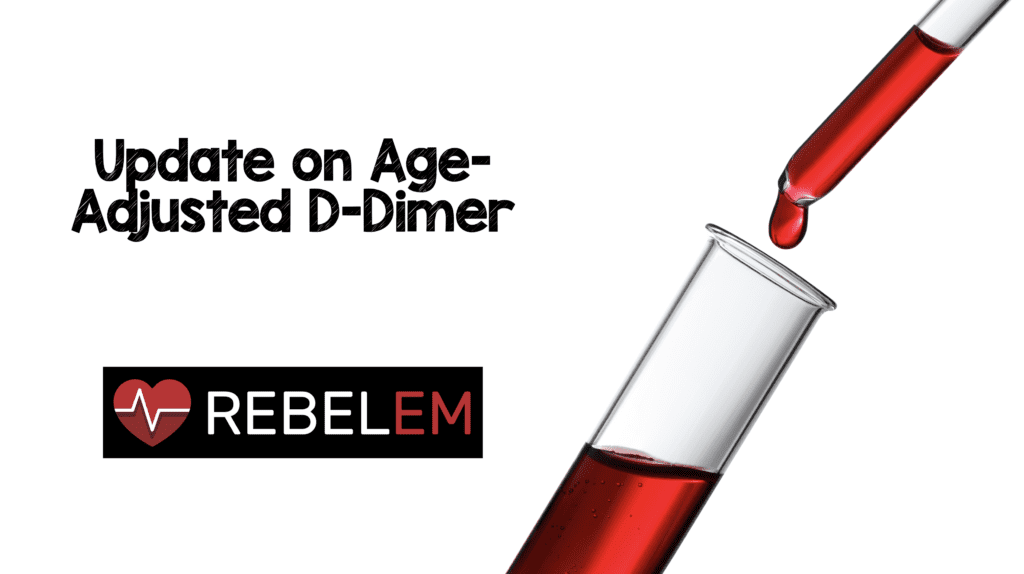
 D-dimer has been shown to increase with age, which can cause a lower specificity (i.e. more false positive tests) in older patients. The result of this would be that older patients would often have more diagnostic imaging or downstream testing, but on the other hand, maybe a higher cut-off d-dimer value may lead to increased false negative cases (i.e. missed venothromboembolism) and make this strategy less safe. Recently, I wrote a post on age-adjusted d-dimer testing on REBEL EM, but since that post there was a new article that was published in Chest 2014. This post, will specifically focus on an update of age-adjusted d-dimer testing based on the above article.
D-dimer has been shown to increase with age, which can cause a lower specificity (i.e. more false positive tests) in older patients. The result of this would be that older patients would often have more diagnostic imaging or downstream testing, but on the other hand, maybe a higher cut-off d-dimer value may lead to increased false negative cases (i.e. missed venothromboembolism) and make this strategy less safe. Recently, I wrote a post on age-adjusted d-dimer testing on REBEL EM, but since that post there was a new article that was published in Chest 2014. This post, will specifically focus on an update of age-adjusted d-dimer testing based on the above article.
What article will we be discussing?
Woller SC et al. Assessment of the Safety and Efficiency of Using an Age-Adjusted D-Dimer Threshold to Exclude Suspected Pulmonary Embolism. Chest 2014. [Ahead of Print] PMID: 24831769
What is the clinical question we are trying to answer?
Is the use of age-adjusted d-dimer testing in patients ≥ 50 years of age safe for clinical practice?
What did they do:
- A retrospective review of 923 patients, age > 50 years evaluated for suspected PE
- All patients had a Revised Geneva Score (RGS) calculated, a d-dimer performed, and a computed tomography pulmonary angiography (CTPA)
- A 64-slice CT scanner was used and high sensitivity d-dimer test (Stago latex agglutination)
- Compared false negative rate for PE of a conventional d-dimer threshold with an age-adjusted d-dimer threshold

Results:
- 104 patients had a negative CONVENTIONAL d-dimer and RGS ≤ 10, with NO PEs observed within 90 days (False Negative Rate = 0%)
- 273 patients had a negative AGE-ADJUSTED d-dimer and RGS ≤ 10, with 4 PEs observed within 90 days (False Negative Rate = 1.5%)
- AGE-ADJUSTED d-dimer resulted in 18.3% absolute reduction in patients age > 50 years who would undergo CTPA vs CONVENTIONAL d-dimer
- In a subcohort evaluation a negative AGE-ADJUSTED d-dimer and RGS≤ 10 was seen in:
- Age > 50 years: 273/923 pts with 4 (1.5%) missed PEs at 90d (95% CI 0.4 – 3.7)
- Age 51 – 65 years: 130/480 pts with 1 (0.8%) missed PEs at 90d (95% CI 0.02 – 4.2)
- Age 66 – 74 years: 66/186 pts with 0 (0.0%) missed PEs at 90d (95% CI 0.0 – 5.4)
- Age ≥ 75 years: 77/257 pts with 3 (3.9%) missed PEs at 90d (95% CI 0.8 – 11.0)
Limitations:
- If you look at each of the sub cohorts in the results section, the maximum confidence interval ranged from 3.7 – 11.0% increasing with age, which means we are potentially missing more PEs in older patients (i.e. upto 11.0% at the maximum CI in patients 75 years and older)
-
 The prevalence of PE in this study was 10.6%. In the US prevalence has been reported as 5.1% [1], but in contrast in European studies the prevalence for PE ranges from 24 – 31% [2] [3] [4].
The prevalence of PE in this study was 10.6%. In the US prevalence has been reported as 5.1% [1], but in contrast in European studies the prevalence for PE ranges from 24 – 31% [2] [3] [4]. - This study was a retrospective chart review, so if hemoptysis or leg edema were not recorded they were considered negative, and actually underestimate RGS. Also how may patients don’t go to doctors and have not had their initial malignancy diagnosed? This will also reduce the RGS, when it is well known that malignancy risk increases with age
- All patients in this study received a CTPA, which is not what is done in clinical practice, and excluded all patients who did not receive imaging. Therefore this study population differs from an unselected patient population, making this a higher risk population for PE
Authors’ Conclusion: Using an age-adjusted d-dimer threshold reduces imaging among patients age > 50 years with a RGS ≤ 10, but at the cost of missing an additional 1.5% of PEs and requires a prospective study before this practice can be adopted into routine clinical care
Take Home Message
Using an age-adjusted d-dimer strategy in patients age > 50 years would result in 18.3% fewer scans, but would miss up to 3.7 – 11.0% of PEs at 90 days of follow up based on the highest confidence intervals. Therefore a prospective, randomized control trial with narrower confidence intervals would be needed before implementing this strategy into clinical practice
References:
- Penaloza A et al. Performance of Age-Adjusted D-Dimer cut-Off to Rule Out Pulmonary Embolism. J thrombi Haemost 2012. PMID: 22568451
- Douma RA et al. Potential of an Age Adjusted D-Dimer Cut-Off Value to Improve the Exclusion of Pulmonary Embolism in Older Patients: A Retrospective Analysis of Three Large Cohorts. BMJ 2010. PMID: 20354012
- Jaffrelot M et al. External Validation of a D-Dimer Age-Adjusted Cut-Off for the Exclusion of Pulmonary Embolism. Thromb Haemost 2012. PMID: 22399072
- van Es J et al. The combination of Four Different clinical Decision rules and an Age-Adjusted D-Dimer cut-Off Increases the Number of Patients in Whom Acute Pulmonary Embolism can Safely be Excluded. Thomb Hadmost 2012. PMID: 22072293
For More on This Topic Checkout:
- Courtney Casella at EMDocs: Age-Adjusted D-Dimer – Is it Ready for Primetime?
The post Update on Age-Adjusted D-Dimer appeared first on REBEL EM - Emergency Medicine Blog.
